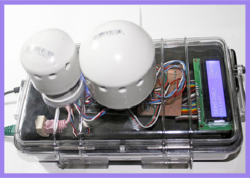Air Quality Egg
The Air Quality Egg (AQE) is an Internet of Things platform and hobbyist device for crowdsourced citizen monitoring of airborne pollutants. The device won widespread recognition when it was named one of the best projects on Kickstarter in 2012,[1] and has been featured in a variety of media outlets.[2] Data from each device is uploaded to Xively and published on the Air Quality Egg website.[3] The device can be used with 3rd-party mobile apps such as Acculation's AQCalc.[4]
How it works (current version)
Version 2 of the AQE is a single unit, Wi-Fi connected device which can be configured using a cell phone. It has two variants; indoor and outdoor. The device can be fitted with sensors for CO2, NO2, SO2, ozone, carbon monoxide, volatile organic compounds and particulates (PM10, PM2.5 and PM1.0). The particulate sensors can detect particles as small as 0.3 μm (microns), using two Plantower PMS5003 laser sensors.
Accuracy
The PM2.5 measurements of the AQE version 2 had an R2 correlation factor of 0.79 to 0.85 with a professional reference sensor, in a field test run by the South Coast Air Quality Management District. (An R2 of 1 indicates perfect correlation, whereas 0 indicates a complete lack of correlation).[5]
History

The AQE grew out of Internet of Things meetup groups in New York City and Amsterdam, led by Pachube evangelist Ed Borden. The concept was conceived at a Parsons/New School hackathon. It is manufactured and sold by the start-up company WickedDevice LLC in Ithaca, NY.[6][7] The name "Air Quality Egg" was created by company co-founder Dirk Swart.[8]
Originally, there were two versions of the device: an Arduino shield for use by hobbyists, and a more consumer-ready "hobbyist kit" device. The latter consists of two identical-looking plastic enclosures resembling white eggs. The base unit is connected to the user's Ethernet LAN connection. A second unit monitors NO2 and CO levels and reports these readings every few minutes to the base unit via a custom wireless protocol. The base unit reports these readings to Xively and the AQE website. Add-ons are available for purchase on the website, that add PM2.5 dust, Ozone, and VOC sensors.[6]
Competition
Despite being labelled a not-consumer-ready "hobbyist" device by the manufacturer,[6] the AQE is one of the few de facto commercially available, comprehensive Internet of Things pollution monitors on the US market.[4]
A number of competing devices have been announced, such as Chemisense Wearable[9] and Foobot[10] (formerly Alima).
Another US crowdsourced air quality monitoring device is CitizenSensor, but it is listed an outgoing project, DIY, and not available for purchase.[11]
A comprehensive Internet of Things air pollution monitoring device is China's iKair (pronounced "I Care"), but it has a closed, proprietary platform rather than the AQE's open source hardware and open data design.[12][13]
In 2014, IBM announced a partnership with the government of China for analytics software to process data from pollution sensors.[14]
See also
- South Coast Air Quality Management District evaluates the performance of low-cost pollutant sensors such as the AQE and publishes evaluation reports on its website.
References
- ↑ Chappell, Bill (9 January 2013). "Kickstarter Pledges Topped $320 Million In 2012; Site Names Year's Top Projects". NPR. https://www.npr.org/sections/thetwo-way/2013/01/09/168959800/kickstarter-pledges-topped-320-million-in-2012-site-names-years-top-projects. Retrieved 2019-12-11.
- ↑ Finley, Klint (June 2014). "The Internet of Things Could Drown Our Environment in Gadgets". Wired. https://www.wired.com/2014/06/green-iot/. Retrieved 2014-08-23.
- ↑ "Air Quality Egg". Wicked Device. http://airqualityegg.com/. Retrieved 2014-08-23.
- ↑ 4.0 4.1 "AQcalc mobile app". Acculation. https://www.acculation.com/blog/2014/01/20/acculation-inc-and-aqcalc-in-the-news/. Retrieved 2019-12-11.
- ↑ "air quality sensor summary reports". http://www.aqmd.gov/aq-spec/evaluations/summary-pm.
- ↑ 6.0 6.1 6.2 "AQE Store". wickeddevice llc. http://shop.wickeddevice.com/product/air-quality-egg/. Retrieved 2014-08-23.
- ↑ "Air Quality Egg earns Ithaca startup a $742,000 grant from National Science Foundation" (in en). Ithaca Journal. https://www.ithacajournal.com/story/news/2018/03/22/air-quality-egg-earns-ithaca-startup-742-000-grant-national-science-foundation/448556002/.
- ↑ "#AirQualityEgg by #SenseMakers". Kickstarter. https://www.kickstarter.com/projects/edborden/air-quality-egg. Retrieved 2014-08-23.
- ↑ Pai, Aditi (18 August 2014). "ChemiSense developing wristworn air quality sensor for people with asthma". MobiHealthNews. http://mobihealthnews.com/35846/chemisense-developing-wristworn-air-quality-sensor-for-people-with-asthma/. Retrieved 2014-08-23.
- ↑ "Foobot - it's all about Indoor Air Quality Monitoring" (in en-US). http://foobot.io.
- ↑ "Citizen Sensor: DIY Pollution Monitoring". CitizenSensor. http://www.citizensensor.cc/. Retrieved 2014-08-23.
- ↑ Liao, Rita (7 July 2014). "Smart Sensor iKair Tells You How To Improve Your Home Environment". TechNode. http://technode.com/2014/07/07/smart-sensor-ikair-tells-improve-home-environment/. Retrieved 2014-08-23.
- ↑ "IKair chinese pollution-monitoring startup". Google/Internet community. https://groups.google.com/forum/#!topic/airqualityegg/ZiSIlKCtmwQ. Retrieved 2014-08-23.
- ↑ Greengard, Samuel (16 August 2014). "Analytics Tools Help China Deal With Air Pollution". Baseline. http://www.baselinemag.com/analytics-big-data/analytics-tools-help-china-deal-with-air-pollution.html. Retrieved 2014-08-23.
External links
 |
